
With Grand Prix Indianapolis and StarCityGames.com Dallas/Fort Worth right around the corner, join us for one last look at the Legacy metagame! This time, we’ll be looking at a mountain of data spanning four Open Series tournaments (Cincinnati, Charlotte, Memphis, and Tampa), which you can download here, as well as some overall deck performances since the release of Dark Ascension (which includes the matches played during the StarCityGames.com Open: Richmond).
We’ll start off with the field breakdown from Cincinnati:
Cincinnati Legacy Open
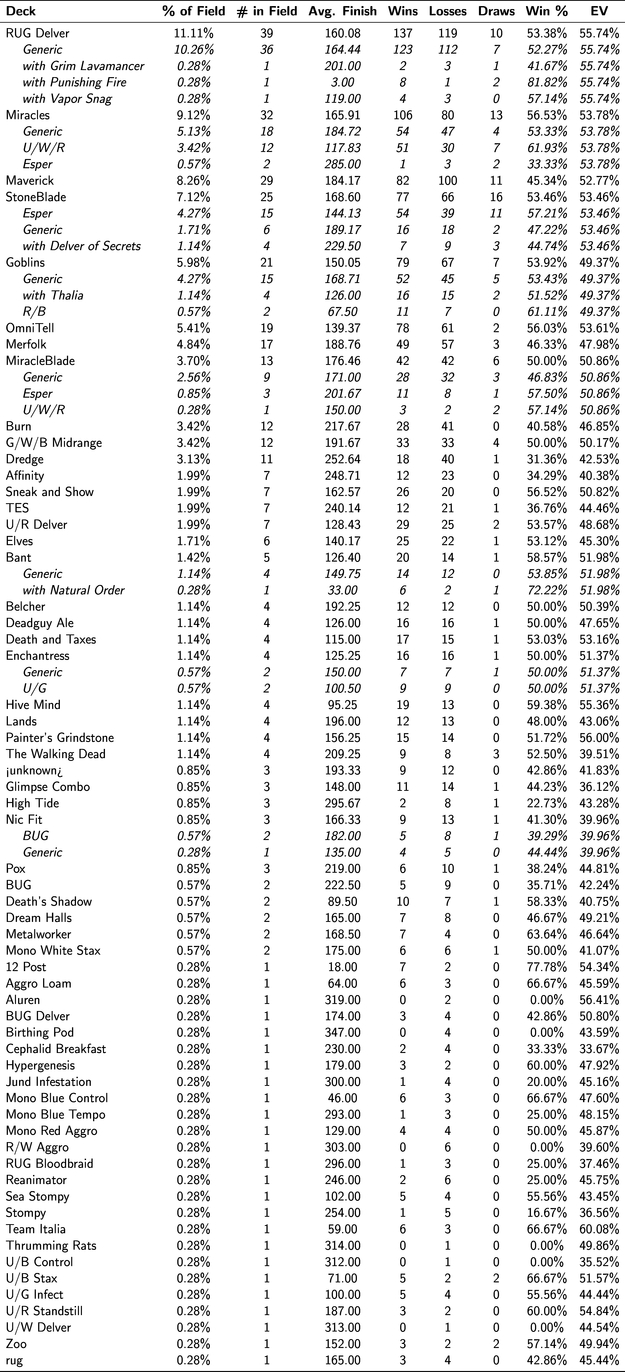
When we analyzed the results from Richmond, it looked like U/W Stoneblade might have been falling out of favor some, but it returned with a vengeance in Cincinnati. The deck commanded a whopping fourteen percent of the field and also boasted a fantastic win percentage. The other story from the weekend is Burn’s surge to second in popularity (nearly ten percent of the players were slinging Lava Spikes!) although its win percentage was decidedly less impressive. RUG Tempo and Maverick both showed up and performed reasonably well. Affinity broke the five percent mark for the first time this year and was represented by just one more player than Dredge, but neither deck managed a positive win record.
We have a lot to cover later in this article, so let’s move right along to Charlotte’s breakdown:
Charlotte Legacy Open
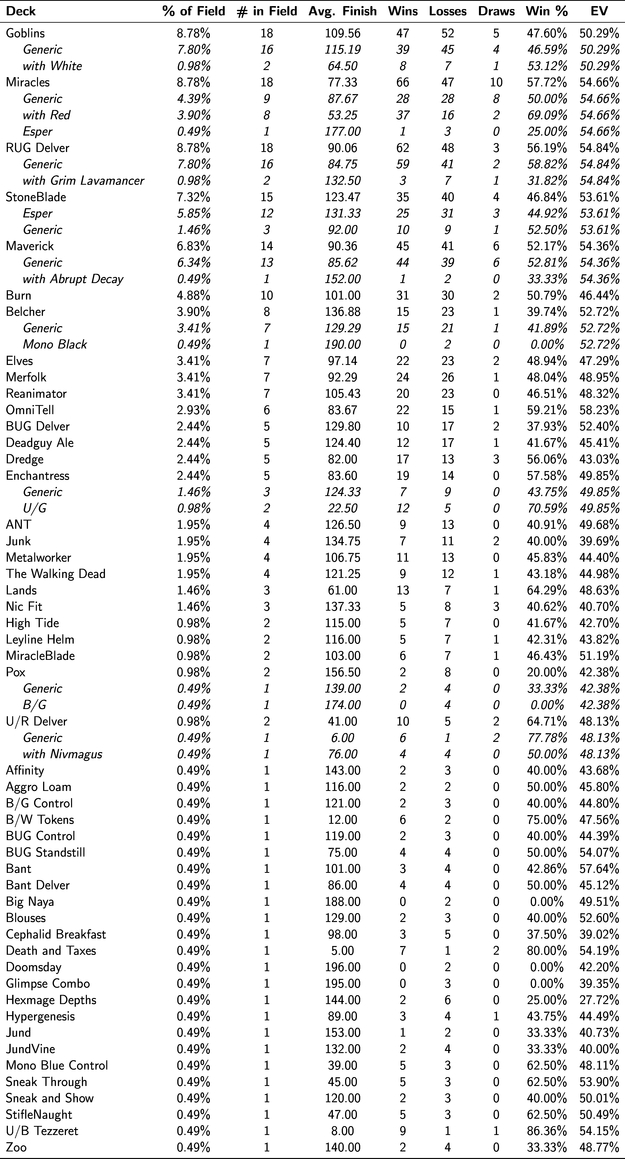
In Charlotte, U/W reprised its role as most popular deck but only won half of its matches. There was no great difference between Stoneblade’s EVs for the two events, so it’s very curious that its performances were so disparate. Maverick was the second most popular deck, and whatever fortune befell Stoneblade in Cincinnati apparently went to the G/W deck in Charlotte—Maverick’s win percentage was awesome. Burn was edged out by Maverick in field presence, landing in third, but it still had a bad weekend in terms of success (albeit not as bad as Cincinnati). Affinity and Dredge made up similarly-sized slices of the field again, and both decks performed poorly again. Finally, the most notable thing about this event is that RUG Tempo, long vying with U/W for the top spot in the format, simply didn’t show up. Only six people played the deck in Charlotte, which was less than four percent of the field. The deck still won more than it lost, but it did underperform its EV by a considerable margin.
Next up is Memphis:
Memphis Legacy Open
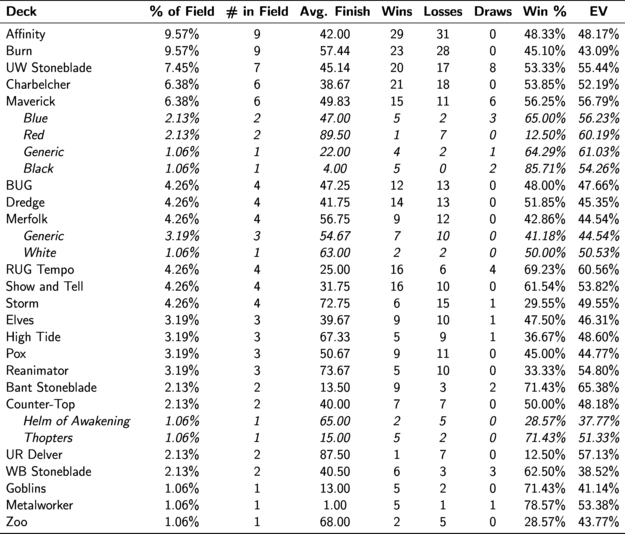
With a headcount of just 94 players, the Memphis Legacy Open was a little smaller than the typical Open Series tournament. As a result, the breakdown from the event looks a little unusual, with unexpected decks showing up near the top presumably due to greater variance.
In other words, yes, it’s strange that Affinity was one of the most popular decks, and no, it probably doesn’t mean that ten percent of the field will be casting Ornithopters in Indianapolis. It’s much less surprising to see Burn where it is, even if it’s above U/W; both decks looked to be surging in prior events. Charbelcher is another oddball, though, tying Maverick in popularity for the first time since the latter’s rise to prominence (though the combo deck couldn’t quite match the G/W deck’s strong performance). The next group of decks, all played by four competitors each, include BUG, Merfolk, Show and Tell, and Storm, all alongside the heavy hitters RUG Tempo and Dredge. Several of these decks had dismal win percentages, but Show and Tell and RUG stand out with very good records.
Finally, here’s the breakdown from Tampa:
Tampa Legacy Open
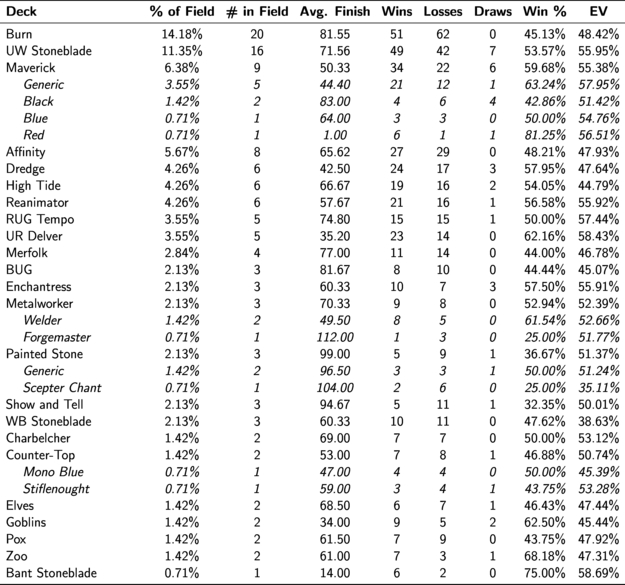
And so the apocalypse cometh. From less than four percent of the field in Richmond, to becoming firmly entrenched among the most popular decks in Cincinnati, Charlotte, and Memphis, to being by far the most popular deck in the room in Tampa, Burn has more or less conquered the Legacy format. The deck has even enjoyed success in the hands of a few of its players, although Burn as an archetype has yet to post a positive win record in any Open Series event this season. We’ll examine the format’s newest boogeyman in detail when we get to matchups.
Despite Burn claiming more than fourteen percent of the competitors in Tampa, more than eleven percent of them played U/W Stoneblade, which was considerably more than Maverick in the third spot. Maverick performed much better, though. Next came Affinity, with much less of a presence than in Memphis, and a group of decks with six players each: Dredge, High Tide, and Reanimator. The fact that High Tide was as popular as Dredge is overshadowed by Dredge’s astounding win percentage, which is far better than the deck’s typical result.
RUG Tempo again failed to break the four percent mark, and this time it matched its lack of popularity with a lack of success, only just winning half of its matches. The same number of players brought U/R Delver, and they were rewarded with one of the best win percentages in the tournament.
Now that we’ve looked at the individual tournaments, we’re going to examine something a little different. What follows is a field breakdown made up of the combined data from all five of the Open Series events since the release of Dark Ascension (the four tournaments we just looked at with Richmond added as well). This chart may not show us the sort of quick metagame shifts that happen week-to-week in the Open Series, but it should describe for us a more general picture of the current Legacy metagame, something that may be useful for those of you preparing for Grand Prix Indianapolis and StarCityGames.com Open: Dallas/Fort Worth.
Combined Breakdown
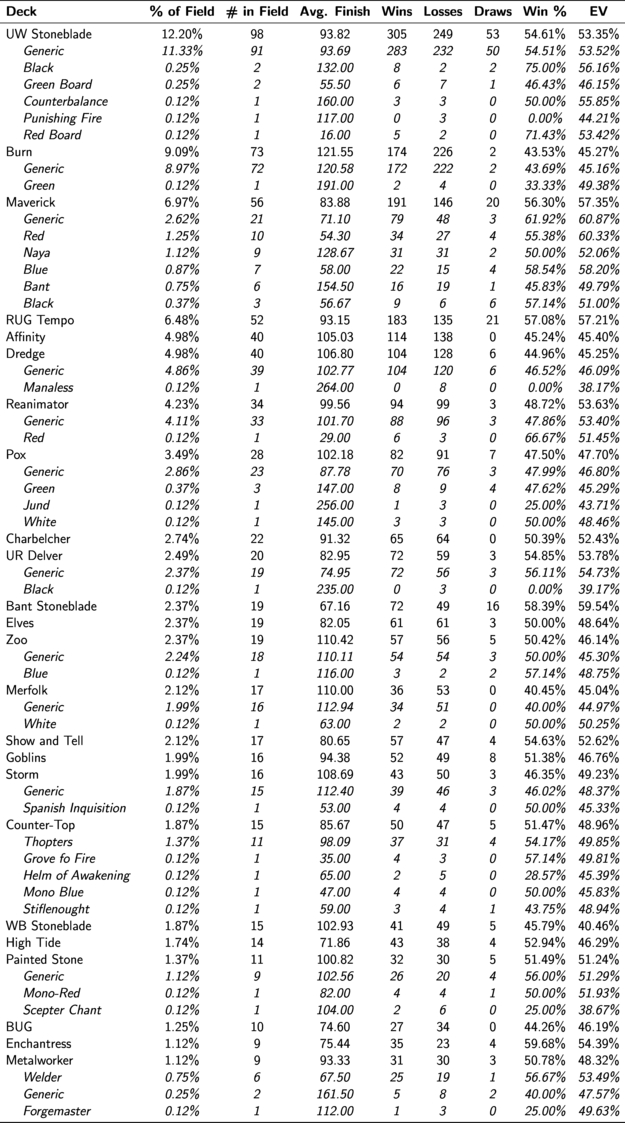
Across these five tournaments, U/W Stoneblade was the most popular deck. It made up over twelve percent of the combined field and backed that up with a strong 54.61% win record.
Burn’s pilots were 9.09% of the total player base, making it the second-most played deck. Its win percentage was dismal, though.
Maverick was the third-most prevalent deck, but that means it was played by barely half as many people as U/W. Its performance was actually a little better than UW’s, though. It’s interesting to note that the breakdown of sub-archetypes under the Maverick header is fairly well distributed. There doesn’t seem to be an agreed-upon build out there.
RUG Tempo may have suffered a bit of a meltdown in the last two Opens, but it still appears as a highly relevant threat in our overall chart. It’s habitually impressive win ratio deserves notice, even if fewer people are playing the deck now.
When we analyzed the data from Richmond, it looked like the printing of Faithless Looting had given Dredge the boost it needed to become one of the most popular decks in Legacy. After five events and at nearly five percent of the entire field, the graveyard-based menace did manage to remain one of the five most popular decks. Its performance was lacking, though. Burn and Dredge both share the dubious distinction of having sub-fifty percent win percentages despite being among the most popular decks in Legacy.
Affinity deserves a mention here too. It was only one player shy of matching Dredge in popularity. However, while Memnite won a few more matches than Ichorid, the artifacts still did pretty poorly.
To look at the performance of individual archetypes, we’ll be using the same data set as this last breakdown. That is, the full five tournaments starting with the Richmond Open. The overall numbers are still calculated using all of the data collected since Innistrad’s release.
U/W Stoneblade – 12.20% of field, won 54.61% of matches
Creatures (11)
Planeswalkers (4)
Lands (20)
Spells (25)


Legacy’s most popular deck had a great month. Its success almost certainly stems from the increased presence of several favorable matchups, including Burn and Affinity. U/W also benefitted some from a favorable round of matches against its former rival, RUG Tempo; in Richmond, we commented on the fact that RUG won most of the matches between the two decks, but that result was reversed in subsequent events. Now the U/W vs. RUG matchup once again appears to favor Stoneblade.
Burn — 9.09% of field, won 43.53% of matches
Creatures (13)
Lands (2)
Spells (45)
- 4 Lightning Bolt
- 17 Mountain
- 4 Fireblast
- 4 Chain Lightning
- 4 Price of Progress
- 4 Lava Spike
- 4 Flame Rift
- 4 Rift Bolt
Sideboard


Whatever is behind Burn’s rise in popularity, it isn’t empirical data. This chart shows one of the worst sets of numbers we’ve ever seen, and it’s shocking to think that it was generated by the second most popular deck across five Legacy Opens.
Burn is historically unfavored against six of these seven decks. Four of those matchups appear relatively close to even, although Burn struggled more with RUG Tempo in the recent events than it has overall.
The only positive matchup that Burn can claim among these decks is Pox, and that’s based on a relatively small amount of data (nineteen matches).
There is little reason to recommend Burn as the deck of choice for Indianapolis or Dallas/Fort Worth.
Maverick – 6.97% of field, won 56.30% of matches
Creatures (22)
- 4 Mother of Runes
- 1 Gaddock Teeg
- 1 Rhox War Monk
- 4 Noble Hierarch
- 4 Knight of the Reliquary
- 2 Qasali Pridemage
- 3 Stoneforge Mystic
- 1 Scavenging Ooze
- 2 Geist of Saint Traft
Lands (22)
Spells (16)


Maverick, on the other hand, looks like a great choice for either of those events. Its great win percentage is obviously due to a bevy of highly positive matchups running across the board. Being ahead against the two most popular decks in the format is certainly a good place to be; crushing the others, on top of that, is just gravy.
It’s also interesting that several of these matchups, specifically those against Burn, RUG Tempo, and Affinity, bore out even better for Maverick in these recent events than they have in the past. This suggests that current Maverick lists have been adapted to better prey on the metagame, which in turn may mean that the deck could be even further improved in the future. That’s a sobering thought, with Maverick already putting up such solid numbers.
RUG Tempo — 6.48% of field, won 57.08% of matches
Creatures (14)
Lands (18)
Spells (28)
- 1 Sensei's Divining Top
- 4 Brainstorm
- 4 Lightning Bolt
- 4 Force of Will
- 1 Island
- 2 Chain Lightning
- 3 Daze
- 3 Stifle
- 2 Spell Snare
- 4 Ponder
Sideboard


RUG is the other deck with an impressive win percentage. Its matchup breakdown doesn’t paint as rosy a picture though; being slightly behind against U/W and well behind against Maverick is probably not where you want to be right now. Smashing Burn is certainly nice, though, as is beating Affinity and Dredge.
Affinity – 4.98% of field, won 45.24% of matches
Creatures (21)
Planeswalkers (3)
Lands (16)
Spells (20)


Affinity’s recent surge in popularity is even harder to understand than Burn’s. It’s had fewer high profile finishes and has even worse matchups across this chart. The fact that Affinity splits with Burn is probably its best selling point.
Dredge – 4.98% of field, won 44.96% of matches
Creatures (22)
- 4 Putrid Imp
- 2 Ichorid
- 1 Flame-Kin Zealot
- 4 Golgari Grave-Troll
- 3 Golgari Thug
- 4 Stinkweed Imp
- 4 Narcomoeba
Lands (14)
Spells (24)


Here we have another deck that beats U/W and Burn and it does so even more handily than Maverick, but Dredge’s overall win percentage was still miserable. This is probably because of the rest of these matchups, especially those against Maverick and RUG which simply appear to be blowouts.
Charbelcher – 2.74% of field, won 50.39% of matches
Spells (47)


We included Belcher in this list because of its surprising prevalence in Memphis. The deck’s win percentage may be unexciting, but it does boast utterly lopsided matchups against Burn and Maverick. Unfortunately, its matchups against U/W and RUG are similarly one-sided in the wrong sense, so Belcher is not likely to be a great choice until people stop playing Force of Will.
Pox – 3.49% of field, won 47.50% of matches
Creatures (2)
Planeswalkers (4)
Lands (25)
Spells (29)
- 4 Hymn to Tourach
- 3 Cursed Scroll
- 4 Dark Ritual
- 1 Nether Void
- 4 Sinkhole
- 1 Pox
- 1 Spinning Darkness
- 3 Innocent Blood
- 4 Smallpox
- 4 Inquisition of Kozilek
Sideboard


Like Belcher, we’re looking at Pox because it spiked in popularity for one tournament (Richmond in this case). We have a little more data to examine now, and the picture it paints isn’t very good.
Pox seems to be well and truly unfavored against U/W, and it also bears the distinction of being the only deck in our group that loses more than it wins against Burn. The rest of the numbers are still pretty sparse, but they indicate a bad matchup against Maverick, which is another strike against the mono-black deck.
Whew! That may seem like a lot to take in. Legacy is as vibrant a format as ever, and with so many distinct archetypes it can be difficult to prepare for an event like a Grand Prix. However, there are some helpful conclusions to be drawn from all of these numbers.
First of all, the top dog of Legacy right now is U/W Stoneblade. The deck is not only popular, but successful as well. It has lots of reasonable matchups across the field and is certainly a solid choice for Indianapolis and Dallas/Fort Worth.
Conversely, Burn is not the deck to play for either of those tournaments. Popular it is, but as more people have picked the deck up we’ve been able to say with more certainty that…they probably shouldn’t. A few pilots in the Open Series have had success with Burn, but the majority of them haven’t. Numbers don’t lie.
The most attractive deck in Legacy right now is undoubtedly Maverick. The deck has a great win percentage backed up by positive matchups where it counts. The only problem is deciding how to build it.
RUG Tempo is another choice that we can recommend. Its matchup spread isn’t as pretty, but you can’t ignore the deck’s simple propensity to win matches.
Few other decks are as compelling as these two right now. Bant Stoneblade consistently puts up good numbers but has remained unpopular enough to call into question the reliability of said numbers. Enchantress and U/R Delver are in similar positions.
Whatever you decide to play, good luck this weekend! Hopefully, we’ll see some of you in Indianapolis!
Alix Hatfield
Jesse Hatfield
